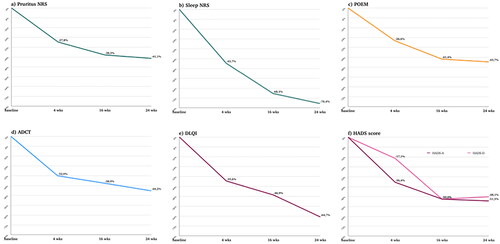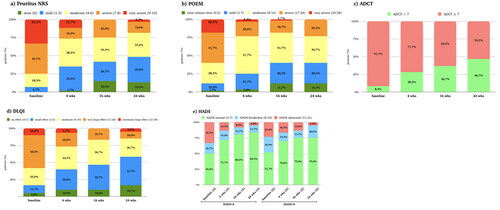Figures & data
Table 1. Epidemiological and clinical characteristics at baseline.
Figure 1. (a–f) Percentage improvement of pruritus NRS (a), sleep NRS (b), POEM (c), ADCT (d), DLQI (e) and HADS-a/HADS-D (f) from baseline at 4, 16 and 24 weeks of treatment. Wks: weeks; NRS: numerical rating scale; POEM: patient-oriented eczema measure; ADCT: atopic dermatitis control tool; DLQI: dermatological life quality index; HADS-A: hospital anxiety and depression scale (anxiety); HADS-D: hospital anxiety and depression scale (depression).

Figure 2. (a–e) Distribution of the population (expressed in percentage) in the different PROs score categories at baseline and after 4, 16 and 24 weeks of therapy. (a) Distribution of the population in the different NRS pruritus score classes at baseline and after 4, 16 and 24 weeks of therapy. Pruritus NRS was classified in five categories: none (0 point), mild (1–3 points), moderate (4–6 points), severe (7–8) and very severe (9–10). (b) Distribution of the population in the different POEM score classes at baseline and after 4, 16 and 24 weeks of therapy. POEM was classified as following: 0–2 (clear/almost clear), 3–7 (mild), 8–16 (moderate), 17–24 (severe), 25–28 (very severe). (c) Distribution of the population in the different ADCT score classes at baseline and after 4, 16 and 24 weeks of therapy. ADCT was classified as following: 0–7 (under control) and ≥7 points (not in control); (d) Distribution of the population in the different DLQI score classes at baseline and after 4, 16 and 24 weeks of therapy DLQI was classified as following: no effect on patient’s life (0–1 points), small effect (2–5 points), moderate effect (6–10 points), very large effect (11–20) and extremely large effect (21–30 points). e) Distribution of the population in the different HADS-a and HADS-D score classes at baseline and after 4, 16 and 24 weeks of therapy. HADS was classified either for anxiety and depression as following: normal (0–7 points), borderline (8–10 points) and abnormal (11–21). Wks: weeks; NRS: numerical rating scale; DLQI: dermatological life quality index; POEM: patient-oriented eczema measure; ADCT: Atopic Dermatitis Control Tool; HADS-A: hospital anxiety and depression scale (anxiety); HADS-D: hospital anxiety and depression scale (depression). Wks: weeks; NRS: numerical rating scale; DLQI: dermatological life quality index; POEM: patient-oriented eczema measure; HADS-A: hospital anxiety and depression scale (anxiety); HADS-D: hospital anxiety and depression scale (depression).

